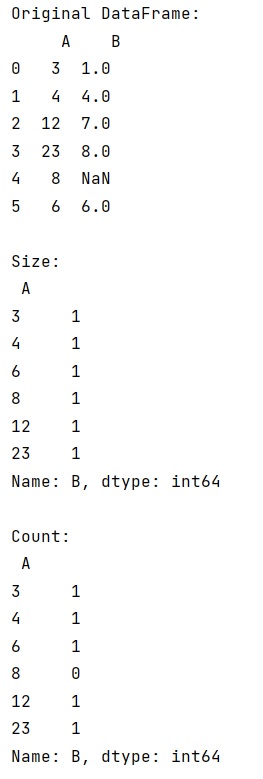Home »
Python »
Python Programs
What is the difference between size and count in pandas?
Learn about the difference between size and count in pandas.
By Pranit Sharma Last updated : October 06, 2023
Pandas is a special tool that allows us to perform complex manipulations of data effectively and efficiently. Inside pandas, we mostly deal with a dataset in the form of DataFrame. DataFrames are 2-dimensional data structures in pandas. DataFrames consist of rows, columns, and data.
Difference between size and count in pandas
The groupby() is a simple but very useful concept in pandas. By using groupby(), we can create a grouping of certain values and perform some operations on those values.
The groupby() method split the object, apply some operations, and then combines them to create a group hence large amounts of data and computations can be performed on these groups.
The groupby() contains some attributes like size and count. The size counts NaNs while count does not". While size does indeed count NaNs, this is a consequence of the fact that size returns the size (or the length) of the object it is called on. Naturally, this also includes rows/values which are NaN.
Let us understand with the help of an example,
Python program to demonstrate the difference between size and count in pandas
# Import pandas
import pandas as pd
# Import numpy
import numpy as np
# Creating a dataframe
df = pd.DataFrame({'A':[3,4,12,23,8,6], 'B':[1,4,7,8,np.NaN,6]})
# Display original dataframe
print("Original DataFrame:\n",df,"\n")
# using groupby size and count and display result
print("Size:\n",df.groupby(['A'])['B'].size(),"\n")
print("Count:\n",df.groupby(['A'])['B'].count(),"\n")
Output
The output of the above program is:

Python Pandas Programs »
Advertisement
Advertisement